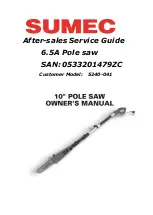
EN
44
19.
Remove Allen keys/spanners etc. before starting the power tool. Always check that Allan keys/
spanners etc. have been removed from the tool before switching it on.
20.
Avoid accidental starting. Carrying a power tool with your finger on the switch, or connecting a
tool to the mains when the switch is in the ON position, increases the risk of accidents and injuries.
21.
Use of extension cords. When working outdoors, only use extension cords approved and
marked for this purpose.
22.
Stay alert. Pay attention to what you are doing, and use your common sense when working with power
tools. Never use power tools if you are tired or under the influence of drugs, alcohol or medication.
23.
Inspect the tool for damage. Always check before using the tool that all safety equipment is in place
and working properly. Check that moving parts are properly adjusted and do not jam, and that no
parts are incorrectly fitted or damaged. Check for other factors that could affect functionality.
24.
Guards or other parts of the power tool that are damaged must be repaired or replaced by an
authorised service centre, unless otherwise specified in these instructions.
25.
Do not use the tool if it cannot be switched on and off with the power switch. Power tools
that cannot be controlled with the power switch are dangerous and must be repaired.
WARNING:
• Only use accessories recommended by the manufacturer. Accessories that are not intended for
the tool can cause personal injury.
• Power tools must only be repaired by qualified personnel.
• This tool conforms with the requirements in relevant safety instructions and standards.
• Repairs must only be carried out by qualified personnel using identical spare parts.
Special safety instructions
1.
Never use blades that are cracked, warped, deformed, or otherwise damaged.
2.
Replace the saw table insert if it is worn.
3.
Only use saw blades recommended by the manufacture that satisfy the requirements in
accordance with the standard EN 847-1.
4.
Do not use high-speed steel blades.
5.
Always wear appropriate personal safety equipment. Depending on the working conditions,
this can include:
– wear ear protection to minimise the risk of hearing damage
– safety glasses
– dust filter mask to minimise the risk of inhaling harmful dust
– protective gloves to minimise the risk of hand injury when handling work pieces and saw
blades (saw blades must be handled and transported as far as possible in the protective
packaging).
6.
The mitre saw must be connected to a dust extractor when cutting wood.
7.
Always use a saw blade intended for the material being cut.












































